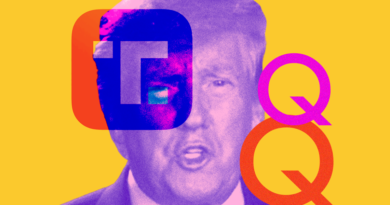What is the QAnon conspiracy theory?
What started as a fringe movement among President Trump’s supporters, confined to the shadier corners of the internet, has taken a mainstream turn. The QAnon conspiracy theory started on 4chan, the bulletin board known for creating and spreading memes, but has moved to larger social media platforms. Facebook has taken action against QAnon groups and pages, while Twitter removed several thousand QAnon-linked accounts in 2020.
The FBI has warned that fringe conspiracy theories like QAnon pose a growing domestic terrorism threat.
What is the QAnon conspiracy theory? What do its followers believe? Those questions have become more difficult to answer as the movement has expanded since its inception in 2017.
The story of Q
QAnon purports that America is run by a cabal of pedophiles and Satan-worshippers who run a global child sex-trafficking operation and that President Trump is the only person who can stop them. The information supposedly comes from a high-ranking government official who posts cryptic clues on 4chan and the even more unfettered site 8chan under the name “Q.”
That’s the central gist of the theory. The rest is open to some degree of interpretation, which is necessary because Q’s posts tend to read like riddles. But YouTube videos created by QAnon believers help fill in the gaps and create a storyline that’s more-or-less comprehensible.
QAnon exists as a kind of parallel history, in which a “deep state” took over decades ago. An all-encompassing theory of the world, it appears to tie together and explain everything from “Pizzagate” to ISIS to the prevalence of mass shootings and the JFK assassination.
It claims the military, supposedly eager to see the deep state overthrown, recruited President Trump to run for president. But the deep state, which controls the media, quickly tried to smear him through “fake news” and unfounded allegations of collusion with Russia. It goes on to insist that despite the deep state’s best efforts, however, President Trump is winning, and that Q is releasing sanctioned leaks to the public in order to galvanize them ahead of “The Storm,” which is the moment when the deep state’s leaders are arrested and sent to Guantanamo Bay. QAnon believers have called this process “The Great Awakening.”
Enter “the storm”
The storm takes its name from President Trump’s enigmatic comment from October 2018 about “the calm before the storm.” Q began posting soon after and said that the storm Mr. Trump referenced is a coming series of mass arrests that would end the deep state forever.
In QAnon lore, President Trump was secretly working with special counsel Robert Mueller to bring the deep state down, and the storm is a kind of Judgment Day in which the evildoers are punished and the faithful are redeemed. Q has repeatedly suggested that the storm would hit in the very near future and has even said certain people would be arrested at certain dates.
When those dates come and go without any arrests, Q says that they needed to be delayed for one reason or another, but that President Trump still has the situation well in hand.
Bakers and breadcrumbs
Q’s posts tend to be either vague or totally incomprehensible, but QAnon believers are more than happy to try and decipher them. Last year, for example, Q posted a photo of an unnamed island chain. Eager to divine the reasoning behind the post, QAnon adherents tried to “prove” that the photo must have been taken on Air Force One and thus that Q was traveling with the president.
The Q posts are known to the faithful as “breadcrumbs.” The people who then try to figure out what they mean are called “bakers.” According to The Daily Beast’s Will Sommer, QAnon believers also spend a lot of time trying to figure out who in the government is a “white hat” Trump supporter and who is a “black hat” in league with the deep state. Their rallying cry is “where we go one, we go all,” a line from the 1996 Jeff Bridges sailing adventure “White Squall” that they misattribute to President Kennedy.
The phrase is frequently abbreviated to “WWG1WGA,” which Roseanne Barr — one of several celebrity QAnon supporters — tweeted in June 2018. Former Red Sox pitcher and current right-wing radio host Curt Schilling has also promoted QAnon online.
Q’s identity
The name refers to Q-level clearance at the Energy Department. But who’s behind the posts is anybody’s guess. According to Sommer, the QAnon faithful sometimes point to former national security adviser Michael Flynn and White House aide Dan Scavino as possibilities. Others believe it’s Mr. Trump himself. Another theory is that John F. Kennedy Jr. faked his death and now posts on 8chan as QAnon.
On November 3, Election Day, 8chan (now 8kun) administrator Ron Watkins resigned from his post. Q did not post for the next week, raising questions about a connection.
Evolution of QAnon
As the QAnon movement has migrated to more mainstream social media platforms such as Facebook and Twitter, it has developed new conspiracy theories that have helped subsume more followers.
Many QAnon supporters believe that President Kennedy was set to reveal the existence of the secret government when he was assassinated. They also believe President Reagan was shot on the deep state’s orders, and that all the presidents since he left office — with the exception of President Trump — have been deep state agents.
QAnon believers have also latched onto other conspiracies, such as the 9/11 “truther” movement and the Rothschild family owning the world’s banks. Different QAnon followers identify with different conspiracies, though they all believe in the central conspiracy of child sex trafficking rings perpetrated by members of the Democratic party.
Most recently, followers have staged several #SaveOurChildren demonstrations.
“It seems like they’ve hijacked the ‘Save Our Children’ movement, infiltrating it and putting their spin on it,” says Daryl Johnson, who previously researched right-wing terrorism for the Department of Homeland Security. “Think about children and how vulnerable they are. The issue really tugs at the hearts of anybody. But they’re linking it to their conspiracy theories, which are crazy and very dangerous.”
According to political science professor Joe Uscinski, who studies conspiracy theories, “The beliefs themselves are almost an incitement to violence. I mean, there isn’t anything worse you can say about your political competitors than that they are satanic sex traffickers who molest and eat children.”
“It has a lot of properties that make it more like a cult,” Uscinski said.
QAnon in Congress
At least 19 House Republican candidates who support or have elevated the QAnon movement were on the November ballot, according to tracking by Media Matters. Two QAnon supporters were elected to the United States House of Representatives:
- Marjorie Taylor Greene won her race for Georgia’s 14th congressional district
- Lauren Boebert won her race for Colorado’s 3rd congressional district
QAnon on social media
QAnon spread from its fringe beginnings on 4chan and 8chan to larger social media platforms such as Facebook, Twitter, and YouTube. These platforms have faced increasing pressure to crack down on these accounts and groups, but have found it difficult to do so.
“QAnon is not one organization that you can just cancel or remove,” says CNET senior producer and CBSN correspondent Dan Patterson.
“For a long time they did little” to moderate QAnon activity, says Patterson. Only in the summer and fall of 2020 have the larger platforms — Facebook, Twitter, and YouTube — taken stronger action, removing groups and banning accounts.
Still, Patterson says, these platforms provide little information beyond numbers of accounts affected. “These organizations are heavily driven by algorithms, and these algorithms really favor engagement, which QAnon is really good at doing.”
*** This article has been archived for your research. The original version from WSGW can be found here ***



